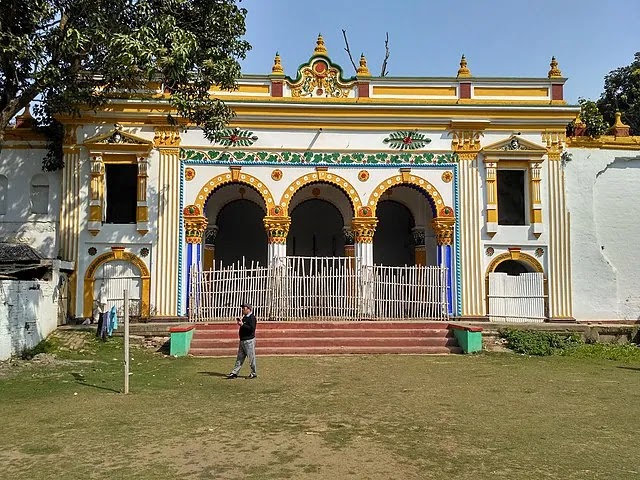Dinajpur Rajbari is in the northeast of Dinajpur district headquarters in Bangladesh. It is near Rajarampur village and is famous as “Raj Batika.”

Raja Dinaj established Dinajpur Rajbari. In the fifteenth century, Ilyas Shahi ruled. “Raja Ganesha” built this house.
More Information About Dinajpur Rajbari
In the seventeenth century, Shrimant Datta Chowdhury became the landlord of Dinajpur. Sadly, Sukhdev Ghosh inherited Shrimant Datta Chowdhury’s property after his son passed away.
The palace is now just a collection of abandoned bricks. The buildings have reached the final stage of falling into pieces. Various kings and landlords constructed it at different times.
This fantastic architecture consists of three main mahals. These are famous as Ayana Mahal, Rani Mahal, and Thakurbari Mahal.
It had temples, rest houses, hospitals, lakes, and residences for servants and pets. The palace has many buildings, two large lakes, gardens, a zoo, a tennis court, and kumar houses.
It covers about 16.41 acres. In the eighteenth century, Maharaja Pranath and his son Ramnath built the main mahal and moat.
This architecture represents European, Muslim, and Hindu styles, which wasn’t appealing. Two parallel moats called Ramdanga surrounded the palace.
Ramnath likely dug the moat during the reign of Alivardi Khan. It was after the invasion by Fauzdar Syed Ahmed Khan of Rangpur.

From 1608 to 1951, the palace was famous as a symbol of wealth in the Dinajpur district. It did not look like this earlier and developed as a majestic place.
The landlord system ended in 1951. It is when the Zamindari Acquisition and Tenancy Act started. From then on, people began to abandon the palace.
The last Zamindar Jagadishnath died in Kolkata, India in 1962. After the abolition of the zamindari system, the royal court started to decline.
It is now only a remnant of a defunct Zamindari time. The authority preserved some items in the National Museum in Dhaka and some in the Dinajpur Museum.
It used to be the home of the powerful Dinajpur Rajas, who ruled for centuries. But, after the partition of India and Pakistan in 1947, people abandoned it, and it fell into ruins.
Today, the palace is a popular tourist spot. But it is not well-maintained. The buildings are collapsing, and it’s in disrepair.
Despite this, the ruins are impressive and offer a glimpse into the region’s history. It has Mughal, Hindu, and European styles, showcasing the diverse culture.
The Mughal influence is visible in the arched doorways and carvings. The temples and shrines reflect the Hindu influence. The symmetry and proportions show the European influence.
Even though it’s in bad shape, it is still worth visiting. It’s a reminder of the region’s rich history and culture and a beautiful place to explore and take photos.
The palace is in poor condition. There are hazards like loose bricks, uneven surfaces, and buildings collapsing. To be comfortable, wear cozy shoes.
Remember to bring a hat and sunscreen. Also, everyone should respect the locals and their culture. The palace lacks shade, but it’s a fascinating place to visit.
Keep in mind its limitations. It’s not well-maintained, but the impressive ruins show the region’s history. There are various theories about the antiquity of this palace.
But it is generally believed to be a 16th-century palace. During the years 1600 to 1650 AD, people constructed the Dinajpur palace. It showcases medieval architecture.
There is not much information about this magnificent architecture. So, there are various theories about the establishment of this palace.
But, according to experts, the soil of Dinajpur is like the soil of ancient places in India. So, experts assume the sixteenth century.

One of the features of this palace is the interest of the kings in various sports. Very few palaces have dedicated sports grounds. This area includes a tennis court.
Raja Kumar was a lover of playing tennis. He built this tennis court. There was a specific mahal named after Raja Kumar in this palace.
Conclusion
This place in the Dinajpur district of Bangladesh has architectural value. Though Dinajpur Rajbari is a part of ruin now, it still attracts people from different areas.
It offers many things to the people who visit to explore it. A wonderful time is possible to enjoy in the area of this old palace, without any doubt.